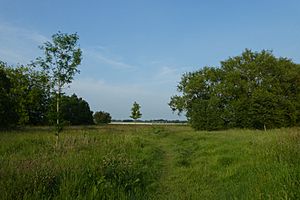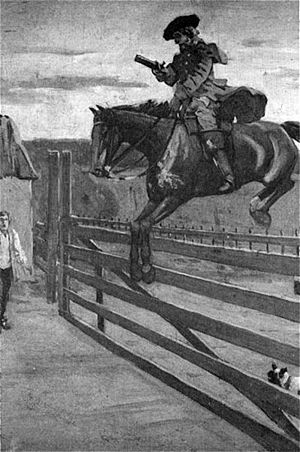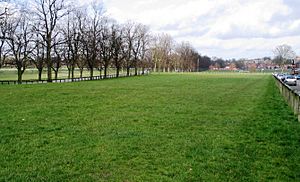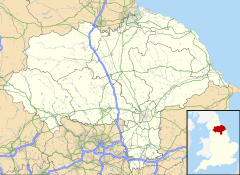Knavesmire facts for kids
Quick facts for kids Knavesmire |
|
|---|---|
 Path on the edge of the Knavesmire |
|
| OS grid reference | SE592499 |
| Unitary authority | |
| Ceremonial county | |
| Region | |
| Country | England |
| Sovereign state | United Kingdom |
| Post town | YORK |
| Postcode district | YO23 |
| Police | North Yorkshire |
| Fire | North Yorkshire |
| Ambulance | Yorkshire |
| EU Parliament | Yorkshire and the Humber |
The Knavesmire is a big, open, grassy area in the city of York, England. It's one of several similar places in York known as Strays. Knavesmire and another area called Hob Moor together make up Micklegate Stray.
Some people think the name 'Knavesmire' might come from the same root as Knaresborough, meaning "Cenward's mire."
Knavesmire is in the south-west part of York, a bit outside the old city walls. Because it's low-lying, it often gets flooded when there's a lot of rain. This is why it stayed open and undeveloped as the city grew around it.
For many years, the York Golf course was located on the Knavesmire.
During World War II, parts of Knavesmire were used for farming to help feed people. Other parts were used by the military. There was an anti-aircraft battery to protect the city and a camp for prisoners of war near the grandstand.
Knavesmire was also home to Knavesmire Secondary School. Later, this became a campus for The College of Law until 2014. Today, Millthorpe School uses Knavesmire for cross country running practice. Knavesmire Primary School is also nearby on Campleshon Road.
In 1864, a letter was sent to the York newspaper from a football club in Leeds. It suggested that people in York should start their own football team and play a friendly match on Knavesmire.

For many years, Knavesmire was the place where public executions happened in York. The gallows were first set up in 1379. This was a few miles outside the city, on the main road leading in from the south (now called the A1036 Tadcaster Road). People often called this execution site "York Tyburn," after a famous site in London.
Some of the most well-known people executed here include Rhys ap Maredudd, a Welsh nobleman, in 1292. Also, Dick Turpin, a famous highwayman, was executed here in 1739.
By the early 1800s, people felt that the gallows didn't give a good first impression to visitors arriving in the city. The last execution at Knavesmire was in 1801. After that, the gallows were moved to a different, more hidden, but still public, spot near the castle. Today, a paved area with a small plaque marks where the scaffold once stood.

Today, Knavesmire is a popular place for people to relax and for public events. It's a great spot for walking dogs. A large part of the area is taken up by York Racecourse. The York Races first moved to Knavesmire from Clifton in 1731. Since 2012, it has also been the location for the York Parkrun. This is a free 5-kilometer running event held every Saturday morning.
Knavesmire also hosts Yorkshire's biggest festival celebrating local drinks. This event has been held on Knavesmire since 2009. The annual York CAMRA Beer & Cider Festival takes place in a large tent opposite the Grandstand.
The Little Knavesmire is the home ground for Ovington Cricket Club.


